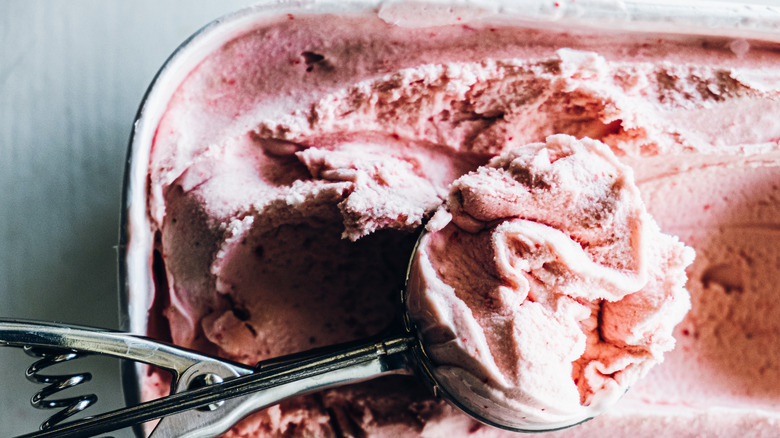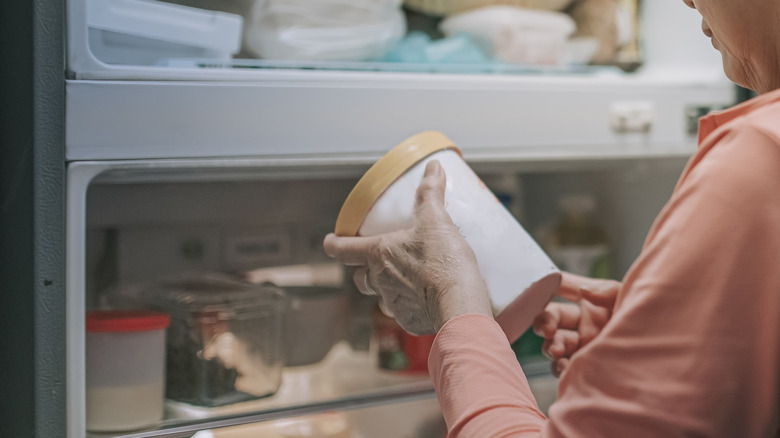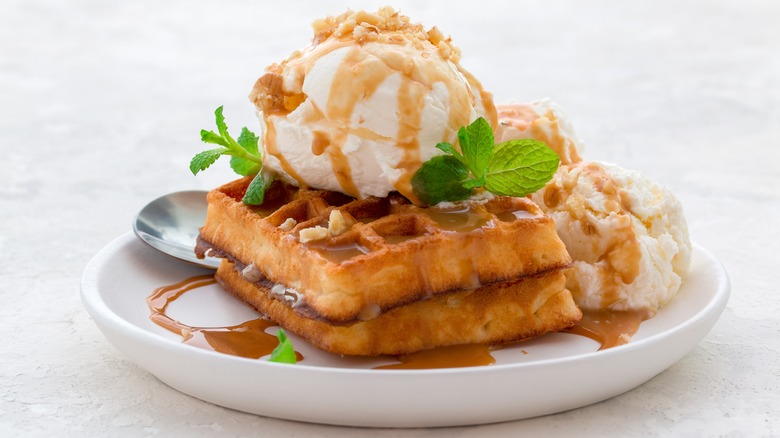When To Throw Out Half-Eaten Ice Cream Containers
While devouring an entire tub of ice cream in one sitting may be the norm for many, there are instances when a portion remains untouched, raising questions about its fate. Maybe you were saving a precious scoop to enjoy the following day, only to let it slip from your memory, or you had to call it quits a few spoons shy of reaching the bottom of the container. Perhaps, you're simply not someone who eats ice cream by the tub. Regardless of the situation, you're now staring at a half-eaten tub of ice cream and contemplating whether it's safe to eat. But before you make that decision, you should know that ice cream can sadly go bad.
Despite the chilling temperatures of a freezer, open containers of ice cream are just as susceptible to spoilage as any other food. A telltale sign of spoiled ice cream is a layer of ice crystals coating the lid or the surface of the dessert. You could still dig past the ice and eat it, but its texture will be greatly compromised. More often than not, however, it's challenging to identify any visible signs of the ice cream's spoilage. In that case, consider how long the half-eaten ice cream has been sitting in the freezer. If it's been over a month or two since you opened the ice cream, it's likely best to just toss it out.
Sadly, half-eaten ice cream can go bad
An unopened tub of ice cream will generally stay fresh till its best-by date — sometimes for even longer than that — but once opened, it should ideally be consumed within a period of 30 to 60 days. Admittedly, that may come as a bit of a shocker, considering that frozen foods are thought to rarely ever go bad. However, that's not always the case, especially when it comes to ice cream.
A tub of ice cream typically has all the protein and water-rich ingredients necessary for foodborne bacteria to thrive, like eggs, cream, and milk. While a freezer can certainly slow the pace at which these bacteria grow, it can't eliminate them entirely, according to the Home and Garden Information Center of Clemson University. As the ice cream is taken out of the freezer and opened, its temperature fluctuates and the ice cream begins to thaw. Under these conditions, bacteria can quickly resume rapid growth.
The bacteria that thrive on ice cream may not be visible to the naked eye, nor might they impart a noticeably bad smell or taste, but rest assured, they remain present in a half-eaten tub. If consumed, this ice cream could result in ailments like Salmonella Enteritidis (SE), per the U.S. Food and Drug Administration (FDA). That's why it may be best to discard the container, or better yet, consume the leftovers before things even get to that point.
Use up those ice cream leftovers
A good way to extend the shelf life of half-eaten ice cream is to ensure that it spends as little time outside the freezer as possible and that any leftovers are stored in air-tight containers. While the original container that the ice cream comes in is fine, make sure that the lid is closed properly before you put it back in the freezer. You can also place a tight layer of plastic wrap between the lid and the container to seal the ice cream from outside moisture. Alternatively, leftovers can also be transferred into more heavy-duty, airtight containers, like Tupperware.
While proper storage may help keep half-eaten ice cream fresh for longer, it's best to find ways to use it up as soon as possible. Of course, you could eat the ice cream plain, but there are other, equally delicious ways to use up the leftovers. A scoop of ice cream on top of warm waffles, pancakes, and French toast can easily upgrade a variety of sweet breakfast recipes. Leftovers can be sandwiched between store-bought cookies for a quick ice cream sandwich fix, slathered between homemade sponges for an ice cream cake, or spooned into buttery tarts as an icy filling. A generous dollop of ice cream can also be the secret ingredient for ultra-thick and creamy milkshakes and iced coffee drinks. Plus, you can always transform leftovers into a sundae with whatever toppings you have on hand, or simply savor the remaining bits with any seasonal fruits.



